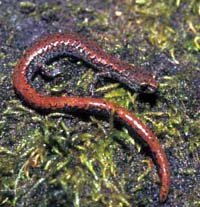Oregon slender salamander facts for kids
Quick facts for kids Oregon slender salamander |
|
|---|---|
 |
|
| Conservation status | |
| Scientific classification | |
| Synonyms | |
|
The Oregon slender salamander (Batrachoseps wrighti) is a small, special type of salamander. It belongs to a family called Plethodontidae, which means they breathe through their skin instead of lungs! This salamander is found only in the Northwestern United States.
Contents
Where Does It Live?
The Oregon slender salamander lives only in north-central Oregon. It is an endemic species, meaning it is found nowhere else in the world. You can mostly find it on the western slopes of the Cascade Range mountains. Sometimes, it is also seen on the eastern slopes.
Why It Needs Our Help
Sadly, the Oregon slender salamander is facing threats. Its home is being destroyed, which is called habitat loss. Because of this, it is listed as a "Vulnerable species" by the IUCN Red List. This means it needs special protection to survive. The United States government also considers it a "Species of Concern." The state of Oregon has listed it as "sensitive" in its Conservation Strategy. All these labels mean people are worried about this salamander and want to help it.
Its Forest Home
This salamander loves to live in cool, moist forests in Oregon. Its natural habitats include woodlands with Douglas fir, maple, and red cedar trees. It can be found at elevations up to about 914 meters (3,000 feet).
These salamanders are often found in old forests. They like places with large, decaying logs and lots of fallen wood. They prefer areas where the tree branches form a thick cover overhead. Sometimes, they can even be found in suburban areas.
What Does It Look Like?
The Oregon slender salamander has a long, thin body. It can grow up to 61 mm (2.4 in) long from its snout to its tail base. Its total length, including the tail, can reach about 120 mm (4.7 in). Most individuals are a bit smaller. They have four toes on their back feet.
Reproduction
Female Oregon slender salamanders lay between 3 and 11 eggs at a time. Each egg is about 4 mm (0.16 in) across.
How It Behaves
When this salamander is found, it often coils its body up. Then, it stays very still. This behavior might help it hide from predators.


